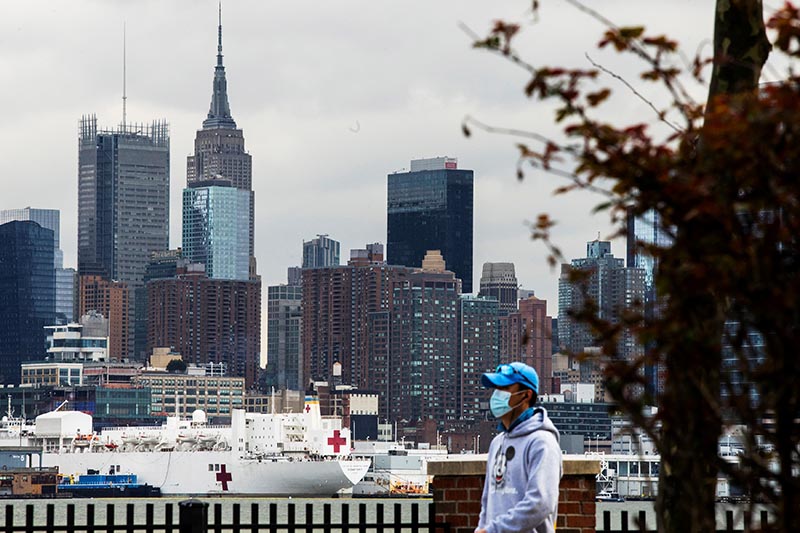US weekly jobless claims seen hovering near record highs
- Weekly jobs claims forecast slipping to 5.25 million
- Estimates for last week's claims as high as 9.295 mln
- Continuing claims for March 28 week seen rising to 8.00 mln
WASHINGTON: The number of Americans seeking unemployment benefits in the last three weeks likely totaled a staggering 15 million as tough measures to control the novel coronavirus outbreak abruptly ground the country to halt, which would cement views the economy was in deep recession.
Thursday's weekly jobless claims report from the Labor Department, the most timely data on the economy's health, would strengthen economists' expectations of job losses of up to 20 million in April. The government reported last Friday that the economy purged 701,000 jobs in March. That was the most job losses since the Great Recession and ended the longest employment boom in U.S. history that started in late 2010.
"These dismal numbers suggest another record-breaking April jobs report," said Beth Ann Bovino, chief U.S economist at S&P Global Ratings in New York. "America is now in recession and as it appears to deepen, the question is how long it will it take before the U.S. recovers."
The number of initial claims for state unemployment benefits probably slipped to a seasonally adjusted 5.250 million for the week ended April 4 from 6.648 million, according to a Reuters survey of economists.
The anticipated lower reading is likely because the model that the government uses to strip out seasonal fluctuations shows a downside bias for last week's data. States also appear to be struggling to process high volumes of claims.
Estimates in the survey were as high as 9.295 million. Going by the average forecast, last week's claims data would bring the cumulative jobless benefits claims to more than 15 million since the week ending March 21.
With more than 95% of Americans under "stay-at-home" or "shelter-in-place" orders, reports continue to mount of state employment offices being overwhelmed by a deluge of applications. Mike Ricci, a spokesman for Maryland Governor Larry Hogan, wrote on Twitter on Wednesday that "we have approximately 1,000 calls coming through in every two hour period of time," noting that "currently, federal employees and people who have worked in multiple states cannot file online."
RANKS OF UNEMPLOYED SWELLING
As such, any moderation in claims last week would probably be temporary. The breadth of businesses shuttered because of the stringent measures to curb the spread of COVID-19, the disease caused by the coronavirus, has expanded from bars, restaurants and other social gathering venues to transportation and factories. The United States has the highest number of confirmed COVID-19 cases in the world.
Businesses are also encouraging their lowest paid hourly workers to apply for unemployment benefits to take advantage of an extra $600 per week for up to four months. This enhancement is part of a historic $2.3 trillion rescue package and is on top of existing jobless benefits, which averaged $385 per person per month in January.
It is equivalent to $15 per hour for a 40-hour workweek. The federal minimum wage is about $7.25 per hour.
"The new $600 Federal payment alone still exceeds average earnings in leisure and hospitality by almost 50%," said Andrew Hunter, a senior US economist at Capital Economics.
"This may in turn be part of the reason why jobless claims have soared so rapidly in recent weeks. Workers may be more accepting of temporary furloughs if they stand to lose little income, and several major retailers have cited the new provisions when announcing layoffs."
Thursday's claims report is also expected to show the number of people continuing to receive benefits after an initial week of aid shot up to 8.0 million in the week ending March 28 from 3.029 million in the prior week, according to the Reuters survey. That would obliterate the record 6.635 million hit in May 2009.
The so-called continuing claims data is reported with a one-week lag and is viewed as a better gauge of unemployment and its impact on gross domestic product.
"The labor market has entered a traumatic period," said Gregory Daco, chief US economist at Oxford Economics in New York. "We foresee the unemployment rate spiking to 14% in April."
The economy is believed to have contracted sharply in the first quarter, with even an historic decline in GDP being forecast for the second quarter. Economists say the economy entered recession in March.
The National Bureau of Economic Research, the private research institute regarded as the arbiter of US recessions, does not define a recession as two consecutive quarters of decline in real gross domestic product, as is the rule of thumb in many countries. Instead, it looks for a drop in activity, spread across the economy and lasting more than a few months.






